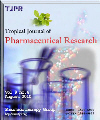
|
Tropical Journal of Pharmaceutical Research
Pharmacotherapy Group, Faculty of Pharmacy, University of Benin, Benin City, Nigeria
ISSN: 1596-5996
EISSN: 1596-5996
Vol. 13, No. 3, 2014, pp. 319-325
|
 Bioline Code: pr14046
Bioline Code: pr14046
Full paper language: English
Document type: Research Article
Document available free of charge
|
|
|
Tropical Journal of Pharmaceutical Research, Vol. 13, No. 3, 2014, pp. 319-325
| en |
Evaluation of In vitro and In vivo Performance of Granisetron In situ Forming Implants: Effect of Sterilization, Storage Condition and Degradation
Algın-Yapar, Evren; Arı, Nuray & Baykara, Tamer
Abstract
Purpose: To investigate the effect of various solvent systems and gamma irradiation on the in vitro and in vivo performance of granisetron HCl injectable phase-sensitive in situ forming implants (ISFIs).
Methods: ISFIs were prepared by mixing and sterilized by gamma irradiation. Effect of solvent system
was studied. Injectability, polymer degradation and stability studies (4 and 25 °C for 4 months), viscosity
measurements, as well as in vitro and in vivo (in rabbits) drug release, and also histological
examinations for biocompatibility studies (in rabbits and rats) were carried out.
Results: ISFIs showed good injectability from 20-gauge needle and their in vitro drug release increased
in the following rank order of solvent/solvent combinations: dimethylsulphoxide (DMSO) >
DMSO:prophylenecarbonate (PC) > DMSO:triacetin(TA) > DMSO:benzylbenzoate (BB). DMSO:PC
incorporating ISFI gave zero order (r2= 0.9503) drug release for 21 days; application of gamma
irradiation accelerated drug release with a difference factor (f1) of 53 but zero order release (r2 = 9690) was maintained. Following test results for DMSO:PC including ISFI as decrease in molecular weight of
polymer was descriptive for drug release behavior and sterilization effect, additionally dynamic
viscosities decreased in line with polymer degradation and all forms of this ISFI showed plastic flow
(fresh, irradiated, aged at 4 and 25 °C for 4 months). In vivo performance showed steady state plasma
drug concentrations between 2 to 21 days with value of 0.55 ± 0.03 μg/ml and biocompatibility was
confirmed by histological results obtained at specific stages of tissue reactions, and also by lack of
fibrous capsule formation.
Conclusion: An ISFI for long-term antiemetic therapy achieved in this preliminary study is promising
and, therefore, further investigations are required.
Keywords
Implant; Poly(DL-lactide-co-glycolide); Granisetron; Gamma irradiation; Sterilization; Degradation; Viscosity; Stability; Pharmacokinetic; Biocompatibility
|
| |
© Copyright 2014 - Tropical Journal of Pharmaceutical Research
Alternative site location: http://www.tjpr.org
|
|
